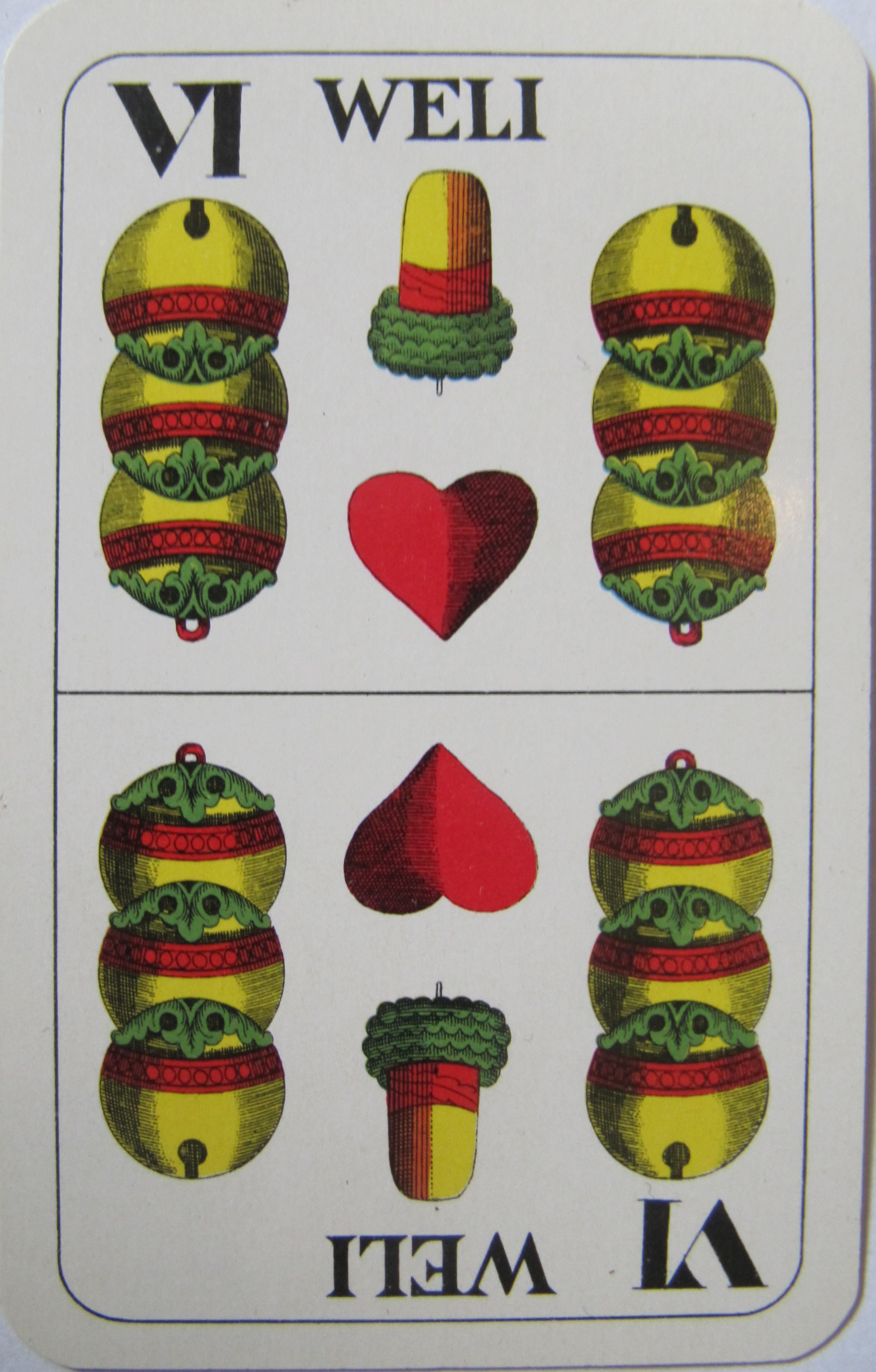Weli Salzburger Bild 1866 on:
[Wikipedia]
[Google]
[Amazon]

 The ''Weli'', formerly ''Welli'', is a playing card used in the Salzburg and William Tell card decks, which are Austrian regional patterns of the German-suited playing cards. It has the value of 6 of Bells and, in the South Tyrol variant of the card game, Watten, it is the only 6 used and can, in addition to its own suit of Bells, join the trump suits of Acorns, Hearts and Leaves. In all other variants of Watten, the 7 of Bells is the ''Weli''.
The ''Weli'', formerly ''Welli'', is a playing card used in the Salzburg and William Tell card decks, which are Austrian regional patterns of the German-suited playing cards. It has the value of 6 of Bells and, in the South Tyrol variant of the card game, Watten, it is the only 6 used and can, in addition to its own suit of Bells, join the trump suits of Acorns, Hearts and Leaves. In all other variants of Watten, the 7 of Bells is the ''Weli''.
Perlaggen
at pagat.com. Retrieved 1 June 2018. In other games, it is simply the six of bells.
The Salzburg deck
{{Playing card Playing cards William Tell deck card games

 The ''Weli'', formerly ''Welli'', is a playing card used in the Salzburg and William Tell card decks, which are Austrian regional patterns of the German-suited playing cards. It has the value of 6 of Bells and, in the South Tyrol variant of the card game, Watten, it is the only 6 used and can, in addition to its own suit of Bells, join the trump suits of Acorns, Hearts and Leaves. In all other variants of Watten, the 7 of Bells is the ''Weli''.
The ''Weli'', formerly ''Welli'', is a playing card used in the Salzburg and William Tell card decks, which are Austrian regional patterns of the German-suited playing cards. It has the value of 6 of Bells and, in the South Tyrol variant of the card game, Watten, it is the only 6 used and can, in addition to its own suit of Bells, join the trump suits of Acorns, Hearts and Leaves. In all other variants of Watten, the 7 of Bells is the ''Weli''.
History
The ''Weli'' is also often called the ''Welli'' or ''Belli'' and, dialectically, the ''Wöli'', ''Wöüli'', ''Bölle'' or ''Belle''. The name ''Weli'' probably comes from the Italian word ''belli'', which means "bells". Historically the ''Weli'' is first recorded in the early 1850s, when a Bozen card manufacturer inscribed ''WELLI'' onto the six of bells. As early as 1855, the ''Weli'' was integrated in the Salzburg pattern as the 6 of Bells. The gravestone appearing in many depictions is probably the grave of theApostle Paul
Paul; grc, Παῦλος, translit=Paulos; cop, ⲡⲁⲩⲗⲟⲥ; hbo, פאולוס השליח (previously called Saul of Tarsus;; ar, بولس الطرسوسي; grc, Σαῦλος Ταρσεύς, Saũlos Tarseús; tr, Tarsuslu Pavlus; ...
.
In the game of Jaggln, the Six of Bells is usually called the ''Buggl'' (Austrian dialect for ''Buckel'', a hump or rounded object, perhaps referring to the shape of the bells).
As a high trump
Games in which the Weli has the role of a matador i.e. high trump include: * Préférence – in a variant played in western Austria the Weli is the 2nd highest trump. * Watten – in the Austrian variant of Critical Watten, the Weli is sometimes the 2nd highest trump. * Perlaggen – the Weli is the 2nd highest permanent 'Perlagg' which may then be used as a wild card (see below).As a wild card
In the Austrian games of Bieten, and Perlaggen, the ''Weli'' acts as a wild card, something which is illustrated by the depiction of two other suits (Acorns and Hearts) on the card and by its special design (it is the only playing card with a printed name).McLeod, JohnPerlaggen
at pagat.com. Retrieved 1 June 2018. In other games, it is simply the six of bells.
References
External links
The Salzburg deck
{{Playing card Playing cards William Tell deck card games